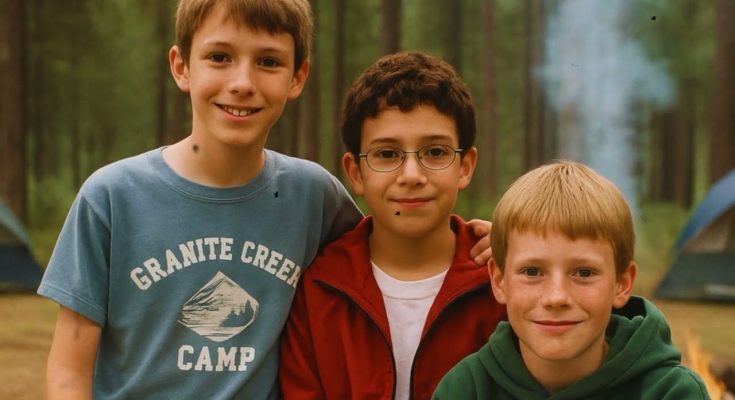Three Boys Vanished From Camp in 2003 — FBI Discovery in 2023 Shocked Everyone | HO

Granite Creek, Idaho — July 2003.
Three boys vanished without a trace from a wilderness camp deep in Idaho’s Salmon-Challis National Forest. Their tent was zipped from the inside. The campfire still burned. There were no footprints, no signs of struggle, no answers. For twenty years, the disappearance of Caleb Thomas, Mason Bell, and Elijah Hartman haunted the region, baffled law enforcement, and left families in a purgatory of hope and grief.
But in September 2023, a single rusted knife found in a forgotten bear cache cracked the case wide open. What followed was a chain of discoveries so disturbing, so methodical, that the case is now being called one of the most chilling child abduction investigations in American history.
The Night They Disappeared
Granite Creek Camp, July 11th, 2003.
The night was cold, the sky moonless, the forest thick with silence. Twelve tents formed a semi-circle around a dying campfire. In tent four, three boys—Caleb, Mason, and Elijah, ages 10 to 11—were the last to sleep, whispering about mountain lions and ghost stories, passing a flashlight back and forth. At 12:17 a.m., the light clicked off. No one heard anything after that—not the nearby counselor, not the other campers, not even the wildlife cameras set up by the US Forest Service, which glitched out for twenty crucial minutes.
By morning, their tent was zipped from the inside, sleeping bags unrolled, a single shoe abandoned. The boys were gone. There were no drag marks, no footprints, nothing but a crude drawing scratched into a pine tree: four stick figures, one upside down.
The FBI joined the search. Helicopters, dogs, and hundreds of volunteers combed the woods. The search grid stretched for miles. But the boys had vanished as if swallowed by the earth itself.
A Clue Surfaces After 20 Years
For two decades, the case went cold. Rumors swirled: animal attack, abduction, even supernatural theories. Then, on September 3rd, 2023, forest ranger Ethan Cordell stumbled on an old bear cache, half-buried and forgotten, miles from the original camp. Inside, he found a hunting knife, heavy and wood-handled, initials “EH” burned into the grip. Below, a crude carving: “2005. Still here.”
Elijah Hartman’s name. But the date was two years after the boys disappeared.
The knife was turned over to Idaho Department of Public Safety forensic investigator Avery Quinn. The woods and rust matched the timeline. It was no hoax. The knife had been there for years.
A Hidden Shelter, a Chilling Discovery
Quinn and Cordell returned to the area with cadaver dogs and ground-penetrating radar. The search led to a slope north of the original camp—an area left unsearched in 2003 after a rock slide. There, hidden beneath branches and earth, they uncovered a sunken wooden structure: a makeshift bunker, professionally reinforced, built to disappear into the landscape.
Inside, the air was cold and stale. There were cots, moldy food containers, and a stack of water-damaged children’s drawings. The sketches showed three boys around a campfire, but in one, a fourth figure was tied to a tree. On a piece of paper, found in a child’s shoe: “I wasn’t alone.”
The most disturbing find was a trapdoor leading to a concrete chamber below. The walls were lined with metal loops. In one corner, a child’s spiral notebook: “Elijah. Elijah. Elijah. He kept calling me Mason. I’m not Mason.”
The Fourth Boy
The original case file had always noted the tree carving: four stick figures, one inverted. But there had never been a fourth camper. Now, the evidence suggested otherwise. Forensic psychologist Dr. Eliza Vaughn, brought in to consult, explained: “This isn’t memory loss. It’s identity rejection. If a child is forced to assume another’s name after trauma, the repetition is resistance—a fight to reclaim selfhood.”
The investigation turned up a witness: Andrea Shipley, the camp’s head counselor in 2003, now living in a care facility. In a halting interview, she recalled seeing a strange boy near the camp the day before the disappearance. “He wasn’t on the roster. I thought he belonged to another group. That night, Elijah asked if it was okay if he stayed in their tent, too. I thought it was a joke.”

But now, it seemed, the boys had let someone in.
A Program of Erasure
The discovery of the shelter set off a chain of revelations. In a hidden compartment beneath the chamber, investigators found a metal box containing a child’s tooth—later matched by DNA to Elijah Hartman, lost naturally at age 11, at least a year after the disappearance. There were also Polaroids: boys in the chamber, bruised, exhausted, forced to repeat names that weren’t theirs.
A pattern emerged: one boy erased, another forced to assume his identity. The evidence pointed to a systematic process—identity erasure and reprogramming.
The Architect: A Shadow in the Woods
A search of old state records uncovered the name Graham Keller, a former military man and field counselor at a defunct “wilderness behavioral facility” that had operated illegally in the region. Keller’s methods were described as “excessive,” his presence at Granite Creek never officially documented.
Avery Quinn tracked Keller’s movements through property records and old staff photos. In 2004, a juvenile guardianship case surfaced: a boy named Caleb Thomas, placed with an anonymous male guardian. The boy matched Elijah’s school photos—he had been living under the wrong name for a decade.
Keller, it appeared, had been running a clandestine program: abducting children, breaking down their identities, and rebuilding them as someone else—replacements for the missing.
A Network of Suffering
The investigation widened. Old maps and missing persons reports revealed at least three similar shelters across Idaho, Oregon, and Utah. Other children had vanished under similar circumstances: church retreats, foster trips, camping excursions. All cases previously unlinked.
The method was chillingly consistent: abduct, isolate, erase, rebuild. If a child resisted, they were “erased.” If they complied, they were “reassigned” and released under a new identity. The FBI now believes at least twelve children were targeted over ten years.
The Student Becomes the Master
In the Wind River Range of Wyoming, agents discovered a new shelter, recently used. Inside: a mirror bolted to the floor, flashcards (“My name is… Say: I am safe now”), and a photograph of four children—two faces scratched out. A laptop contained logs of “conditioning sessions,” the last dated just days before the raid.
Trail cameras captured a young man, late 20s, watching the shelter. He was not Keller, but someone trained in his methods—a former victim, now replicator.
In Oregon, agents found a shipping container converted into a transition chamber. Inside: a boy’s sneaker with a new name, “M Lang, 2023,” and a notebook: “He says I’m Mason. But I’m not Mason. My name is Miles.” The boy, Miles Lang, age nine, was found alive, shivering in the woods. He had been taught to deny his own name.
Revelations and Reckoning
The FBI’s digital forensics team recovered dozens of tapes from the shelters. The footage showed children forced to repeat new names, punished for resisting, and praised for compliance. In one, a boy whispers, “I’m Mason,” only to be corrected: “No, you’re Caleb. Say it again.”
DNA evidence confirmed that at least one child, the real Caleb Thomas, had survived under a false identity for years. Others were not so lucky. Some were found buried near the shelters. Some are still missing.
The mastermind, Graham Keller, was never captured. His disciple—a former victim, now adult—was arrested in Wyoming, but refused to speak except to say, “I was just continuing the lesson.”
A Survivor Returns
In Fort Collins, Colorado, agents finally located “Evan Miles,” a private security worker whose biometric data matched the missing Caleb Thomas. He had no memory of the woods, or the boys, or the fire. But when shown the old flashcards, something surfaced. “I remember Mason,” he whispered.
He was one of only a handful to survive the program and reclaim his identity.
A Memorial and a Warning
On July 11th, 2024, survivors, families, and agents gathered at Granite Creek Camp. A ring of twelve stones—one for each child found during the dismantling of Keller’s network—surrounded a new fire pit. A brass plaque bore the names of the three boys who vanished in 2003: Caleb, Mason, Elijah. And beneath the old pine tree, the one with the four stick figures, a new inscription: “Taken, rewritten, never forgotten.”
The fire burned late into the night, not as a symbol of destruction, but of survival. The case of the Granite Creek boys was no longer a cold case. It was a warning—a testament to the resilience of children, and the darkness that can hide in the wilderness, and in the minds of those who seek to erase the very core of who we are.
If you have information about unsolved disappearances in the region, contact the FBI’s Child Abduction Rapid Deployment Team. The search for answers—and for lost names—continues.



